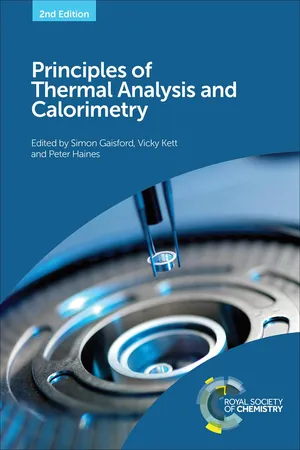
- 280 pages
- English
- ePUB (mobile friendly)
- Available on iOS & Android
Principles of Thermal Analysis and Calorimetry
About this book
The use of thermal and calorimetric methods has shown rapid growth over the past few decades, in an increasingly wide range of applications. The original text was published in 2001; since then there have been significant advances in various analytical techniques and their applications. This second edition supplies an up to date, concise and readable account of the principles, experimental apparatus and practical procedures used in thermal analysis and calorimetric methods of analysis. Written by experts in their field, brief accounts of the basic theory are reinforced with detailed technical advances and contemporary developments. Where appropriate, applications are used to highlight particular operating principles or methods of interpretation.
As an important source of information for many levels of readership in a variety of areas, this book will be an aid for students and lecturers through to industrial and laboratory staff and consultants.
Frequently asked questions
- Essential is ideal for learners and professionals who enjoy exploring a wide range of subjects. Access the Essential Library with 800,000+ trusted titles and best-sellers across business, personal growth, and the humanities. Includes unlimited reading time and Standard Read Aloud voice.
- Complete: Perfect for advanced learners and researchers needing full, unrestricted access. Unlock 1.4M+ books across hundreds of subjects, including academic and specialized titles. The Complete Plan also includes advanced features like Premium Read Aloud and Research Assistant.
Please note we cannot support devices running on iOS 13 and Android 7 or earlier. Learn more about using the app.
Information
1.1 Introduction
1.2 The Early Years
1.3 TMG Committee Structure
| 1965 | Robert Mackenzie | Macaulay Institute for Soil Research, Aberdeen |
| 1967 | John Redfern | Battersea College of Technology, London |
| 1969 | David Dollimore | University of Salford |
| 1971 | John Sharp | University of Sheffield |
| 1973 | Keith Barrett | ICI Dyestuffs/Patent Office |
| 1975 | Fred Wilburn | Pilkington Bros. Ltd. |
| 1977 | Dick Still | University of Manchester Institute of Science and Technology |
| 1979 | Ted Charsley | Stanton Redcroft Ltd |
| 1981 | Graham Clarke | North East Surrey College of Technology |
| 1983 | Peter Laye | University of Leeds |
| 1985 | Derek Nowell | Hatfield Polytechnic |
| 1987 | Peter Haines | Kingston Polytechnic |
| 1989 | Jenny Hider | Consultant |
| 1991 | Bob Whitehouse | Cabot Plastics |
| 1993 | David Morgan | British Geological Survey |
| 1995 | Jezz Leckenby | TopoMetrix Corporation |
| 1997 | Steve Warrington | Loughborough University |
| 1999 | Trevor Lever | TA Instruments |
| 2001 | Jim Ford | Liverpool John Moores University |
| 2003 | Keyna O’Reilly | University of Oxford |
| 2004 | Mark Phipps | TA Instruments |
| 2006 | Mike Reading | University of East Anglia |
| 2008 | Simon Gaisford | School of Pharmacy, University of London |
| 2010 | Ian Priestley | Syngenta Ltd, Huddersfield |
| 2012 | Paul Gabbott | PETA Solutions |
| 2014 | Vicky Kett | Queen’s University Belfast |
| Cyril Keattch | 1965–1999 | Industrial and Laboratory Servic... |
Table of contents
- Cover
- Title
- Copyright
- Preface
- Contents
- 1 TMG History
- 2 Thermal Analysis Nomenclature
- 3 Thermogravimetry
- 4 Dynamic Vapour Sorption
- 5 Differential Scanning Calorimetry
- 6 Modulated Temperature Differential Scanning Calorimetry
- 7 Isothermal Microcalorimetry
- 8 Isothermal Reaction Calorimetry and Adiabatic Calorimetry
- 9 Thermomechanical, Dynamic Mechanical and Dielectric Methods
- 10 Simultaneous Thermal Techniques
- 11 Sample Controlled Thermal Analysis
- Subject Index